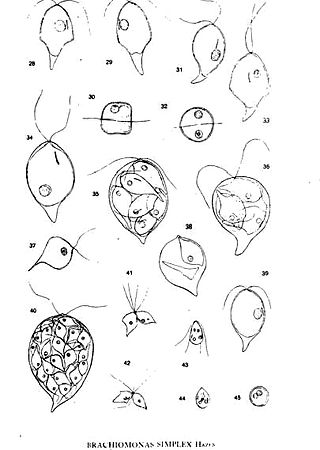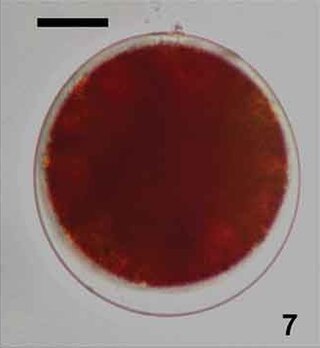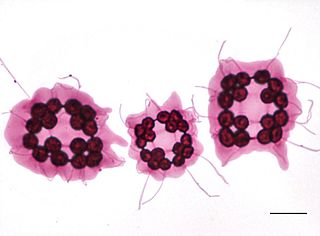
Chlamydomonadales, also known as Volvocales, are an order of flagellated or pseudociliated green algae, specifically of the Chlorophyceae. Chlamydomonadales can form planar or spherical colonies. These vary from Gonium up to Volvox. Each cell has two flagella, and is similar in appearance to Chlamydomonas, with the flagella throughout the colony moving in coordination.

The water net is a taxon of freshwater green algae in the family Hydrodictyaceae. Hydrodictyon does well in clean, eutrophic water, and has become a nuisance in New Zealand, where it has been recently introduced. The name water net comes from the mesh structure of their colonies, which can extend several decimeters.

Ulothrix is a genus of green algae in the family Ulotrichaceae.

Bryopsidales is an order of green algae, in the class Ulvophyceae.
Asteromonas is a genus of green algae in the family Asteromonadaceae. It has been described from saline, marine, and brackish environments. It is closely related to the genus Dunaliella, another species common in saline waters.
Atractomorpha is a genus in the Sphaeropleaceae, a family of green algae. The genus name is derived from Greek and means "spindle-shaped" or "arrow-shaped", and refers to the shape of the cells.

Brachiomonas is a genus of thalloid biflagellate green algae. These algae generally are found in marine or brackish waters, but can tolerate wide range of salinities. They may occur in freshwater pools near the sea and, occasionally, in polluted inland freshwater habitats.
Characiochloris is a genus of green algae in the family Characiochloridaceae. Characiochloris is epiphytic on freshwater algae, or found in soil.
Characiosiphon is a genus of green algae in the family Characiosiphonaceae. It contains a single species, Characiosiphon rivularis.

Chlainomonas is a genus of algae in the family Chlamydomonadaceae. They are found in freshwater habitats or on snow, where they are one of the main algae responsible for causing watermelon snow.
Lobocharacium is a genus of green algae in the family Characiosiphonaceae. It contains the single species Lobocharacium coloradoense. It has been isolated from a pond in Colorado, United States.

Platydorina is a genus of microscopic green algae in the family Volvocaceae. It contains only one species, Platydorina caudata. It was described by Charles Atwood Kofoid in 1899.

Sorastrum is a genus of green algae in the family Hydrodictyaceae. It is a component of the phytoplankton of freshwater ponds, lakes, and ditches. Sorastrum is common in tropical to temperate regions of the world, but due to its small size it is often overlooked.
Treubaria is a genus of green algae, the sole genus in the family Treubariaceae. Treubaria is found in freshwater habitats and has a cosmopolitan distribution.
Spinoclosterium is a genus of green algae, specifically of the Closteriaceae. It is rare, but widely distributed in freshwater regions throughout the world.
Actinochloridaceae is a family of green algae, in the order Chlamydomonadales.
Chlorotetraedron is a genus of green algae, in the family Neochloridaceae. The name may also be written as Chlorotetraëdon. It is found as freshwater plankton or in soil.
Korshikoviella is a genus of green algae in the family Characiaceae.

Scytothamnus australis is a brown alga species in the genus Scytothamnus found in New Zealand. It is a sulphated polysaccharide and the type species in the genus.
Bracteamorpha is a genus of green algae in the order Sphaeropleales, and is the only genus in the family Bracteamorphaceae. It contains a single species, Bracteamorpha trainorii.









